Physical and Mechanical Properties of Reclaimed Asphalt Pavement (RAP) Incorporated into Unbound Pavement Layers
Abstract
1. Introduction
2. Review of Related Studies
3. Materials and Methods
3.1. Materials
3.2. Methodology
3.2.1. General Description
3.2.2. Physical Properties: Grain Size Analysis
3.2.3. Physical Properties: OMC and Dry Density
3.2.4. Mechanical Properties: CBR
3.2.5. Mechanical Properties: Resilient Modulus and Permanent Deformation
4. Results and Discussion
4.1. Physical Properties
4.2. CBR Results
4.3. Triaxial Test Results
4.3.1. Resilient Modulus
4.3.2. Permanent Deformation
5. Conclusions and Future Recommendations
- ▪ Compared to pure VA, the addition of RAP to VA results in a somewhat finer blend, while the gradation and compaction properties of RAP-VA blends are acceptable and within the specified limits;
- ▪ The addition of RAP to the blend lowers the CBR value and this reduction reaches up to 50% when 40% RAP is added to VA;
- ▪ The value of MR is higher than that of pure VA in all the RAP-VA blends studied;
- ▪ All the blends with RAP develop lower permanent deformations than the blend with 100% VA for the same loading history of 1500 cycles. In particular, blend E with the higher percentage of RAP has the lowest deformation value among all the blends;
- ▪ Based on the current experimental findings, it seems that selecting RAP proportions up to 40% is a rational approach to develop RAP-VA mixes that are to be incorporated into unbound pavement layers, since the physical and especially mechanical properties of RAP-VA blends are similar or better than natural aggregates.
Author Contributions
Funding
Institutional Review Board Statement
Informed Consent Statement
Data Availability Statement
Conflicts of Interest
References
- Hamza, M.; Nie, Z.; Aziz, M.; Ijaz, N.; Ijaz, Z.; Rehman, Z.U. Strengthening potential of xanthan gum biopolymer in stabilizing weak subgrade soil. Clean. Technol. Environ. Policy 2022, 24, 2719–2738. [Google Scholar] [CrossRef]
- Ijaz, N.; Ye, W.; Rehman, Z.U.; Ijaz, Z.; Junaid, M.F. New binary paper/wood industry waste blend for solidification/stabilization of problematic soil subgrade: Macro-micro study. Road Mater. Pavement Des. 2022, 1–18. [Google Scholar] [CrossRef]
- Yao, Y.; Li, J.; Liang, C.; Xin, H. Effect of coarse recycled aggregate on failure strength for asphalt mixture using experimental and DEM method. Coatings 2021, 11, 1234. [Google Scholar] [CrossRef]
- Kumar, P.; Shukla, S. Flexible pavement construction using different waste materials: A review. Mater. Today Proc. 2022, 65, 1697–1702. [Google Scholar] [CrossRef]
- Zhang, J.; Zhang, A.; Li, J.; Li, F.; Peng, J. Gray correlation analysis and prediction on permanent deformation of subgrade filled with construction and demolition materials. Materials 2019, 12, 3035. [Google Scholar] [CrossRef]
- Rehman, Z.U.; Khalid, U.; Ijaz, N.; Mujtaba, H.; Haider, A.; Farooq, K.; Ijaz, Z. Machine learning-based intelligent modeling of hydraulic conductivity of sandy soils considering a wide range of grain sizes. Eng. Geol. 2022, 311, 106899. [Google Scholar] [CrossRef]
- Pasandín, A.; Pérez, I. Laboratory evaluation of hot-mix asphalt containing construction and demolition waste. Constr. Build. Mater. 2013, 43, 497–505. [Google Scholar] [CrossRef]
- Del Rey, I.; Ayuso, J.; Barbudo, A.; Galvín, A.; Agrela, F.; de Brito, J. Feasibility study of cement-treated 0–8mmrecycled aggregates from construction and demolition waste as road base layer. Road Mater. Pavement Des. 2016, 17, 678–692. [Google Scholar] [CrossRef]
- Cabalar, A.; Hassan, D.; Abdulnafaa, M. Use of waste ceramic tiles for road pavement subgrade. Road Mater. Pavement Des. 2017, 18, 882–896. [Google Scholar] [CrossRef]
- Jaawani, S.; Franco, A.; De Luca, G.; Coppola, O.; Bonati, A. Limitations on the Use of Recycled Asphalt Pavement in Structural Concrete. App. Sci. 2021, 11, 10901. [Google Scholar] [CrossRef]
- Plati, C. Sustainability factors in pavement materials, design, and preservation strategies: A literature review. Constr. Build. Mater. 2019, 211, 539–555. [Google Scholar] [CrossRef]
- Montañez, J.; Caro, S.; Carrizosa, D.; Calvo, A.; Sánchez, X. Variability of the mechanical properties of Reclaimed Asphalt Pavement (RAP) obtained from different sources. Constr. Build. Mater. 2020, 230, 116968. [Google Scholar] [CrossRef]
- Copeland, A. Reclaimed Asphalt Pavement in Asphalt Mixtures: State of the Practice; Report FHWA-HRT-11-021; Turner-Fairbank Highway Research Center: McLean, VA, USA, 2011.
- Tarsi, G.; Tataranni, P.; Sangiorgi, C. The Challenges of Using Reclaimed AsphaltPavement for New Asphalt Mixtures: A Review. Materials 2020, 13, 4052. [Google Scholar] [CrossRef] [PubMed]
- Mujtaba, H.; Khalid, U.; Rehman, Z.U.; Farooq, K. Recycling of reclaimed subbase materials in flexible pavement design. Road Mater. Pavement Des. 2022, 23, 2713–2732. [Google Scholar] [CrossRef]
- Taha, R.; Ali, G.; Basma, A.; Al-Turk, O. Evaluation of Reclaimed Asphalt Pavement Aggregate in Road Bases and Subbases. Trans. Res. Rec. 1999, 1652, 264–269. [Google Scholar] [CrossRef]
- Puppala, A.; Sireesh, S.; Williammee, R. Sustainable reuse of limestone quarry fines and RAP in pavement base/subbase layers. J. Mater. Civil Eng. 2011, 24, 418–429. [Google Scholar] [CrossRef]
- Edil, T.B. A Review of Recycled Aggregates (RAP and RCA) as Unbound Base Course Material for Sustainable Highway Construction. In Proceedings of the 4th Congrès International de Géotechnique—Ouvrages—Structures, Ho Chi Minh City, Vietnam, 26–27 October 2017; pp. 3–14. [Google Scholar]
- Ullah, S.; Tanyu, B.F. Methodology to develop design guidelines to construct unbound base course with reclaimed asphalt pavement (RAP). Constr. Build. Mater. 2019, 223, 463–476. [Google Scholar] [CrossRef]
- Bennert, T.; Maher, A. The Development of a Performance Specification for Granular Base and Subbase Material; Publication FHWA-NJ-05-003; FHWA, US Department of Transportation: Washington, DC, USA, 2005.
- Seferoglu, A.G.; Seferoglu, M.T.; Akpinar, M.V. Experimental study on cement treated and untreated RAP blended bases: Cyclic plate loading test. Constr. Build. Mater. 2018, 182, 580–587. [Google Scholar] [CrossRef]
- Pradhan, S.K.; Biswal, G. Utilization of reclaimed asphalt pavement (RAP) as granular sub-base material in road construction. Mater. Today: Proc. 2022, 60, 288–293. [Google Scholar] [CrossRef]
- Kim, W.; Labuz, J.F.; Dai, S. Resilient Modulus of Base Course Containing Recycled Asphalt Pavement. Trans. Res. Rec. 2007, 2005, 27–35. [Google Scholar] [CrossRef]
- Edil, T.B.; Tinjum, J.M.; Benson, C.H. Recycled Unbound Materials; Report no MN/RC 2012-35; Minnesota Department of Transportation: Saint Paul, MN, USA, 2012.
- Ullah, S.; Tanyu, B.F.; Hoppe, E.J. Optimizing the Gradation of Fine Processed Reclaimed Asphalt Pavement and Aggregate Blends for Unbound Base Courses. Trans. Res. Rec. 2018, 2672, 57–66. [Google Scholar] [CrossRef]
- Jeon, E.; Steven, B.; Harvey, J.T. Comprehensive Laboratory Testing and Performance Evaluation of Recycled Pulverized Hot-Mix Asphalt Material. Trans. Res. Rec. 2009, 2104, 42–52. [Google Scholar] [CrossRef]
- Arshad, M.; Ahmed, M.F. Potential use of reclaimed asphalt pavement and recycled concrete aggregate in base/subbase layers of flexible pavements. Constr. Build. Mater. 2017, 151, 83–97. [Google Scholar] [CrossRef]
- Ullah, S.; Tanyu, B.F.; Dawson, A. Reclaimed Asphalt Pavement (RAP) as an Unbound Base Course Material: A Mechanistic Design Approach Based on Multi-stage Repeated Load Triaxial Tests. Transp. Geotech. 2022, 33, 100729. [Google Scholar] [CrossRef]
- Ullah, S.; Tanyu, B.F. Effect of variation in moisture content on the mechanical properties of base course constructed with RAP-VA blends. In Proceedings of the Geo-Congress 2020: Geotechnical Earthquake Engineering and Special Topics, American Society of Civil Engineers, Minneapolis, MN, USA, 25–28 February 2020; pp. 612–620. [Google Scholar]
- Bilodeau, J.; Gonzalez, E.L.P. Permanent deformation analysis of base layers with recycled material: Effect of density and stress level. Trans. Geotech. 2021, 27, 100466. [Google Scholar] [CrossRef]
- Defoe, J. Use of Recycled Asphalt Materials in the Construction of a Bituminous Stabilized Base; Final Report; Michigan Department of Transportation: Lansing, MI, USA, 1982.
- Maher, M.H.; Gucunski, N.; Papp, W.J., Jr. Recycled asphalt pavement as a base and sub-base material. ASTM Spec. Technol. Publ. 1997, 1275, 42–53. [Google Scholar]
- Bennert, T.; Papp, W.J.; Maher, A.; Gucunski, N. Utilization of Construction and Demolition Debris under Traffic-Type Loading in Base and Subbase Application. Trans. Res. Rec. 2000, 1714, 33–39. [Google Scholar] [CrossRef]
- Song, Y.; Ooi, P.S.K. Resilient modulus characteristics of varying percent of reclaimed asphalt pavement. In Proceedings of the GeoShanghai International Conference, Shanghai, China, 3–5 June 2010; pp. 43–50. [Google Scholar]
- McGarrah, E. Evaluation of Current Practices of Reclaimed Asphalt Pavement/Virgin Aggregate as Base Course Material; Report no WA-RD 713.1; University of Washington, Department of Civil and Environmental Engineering: Seattle, WA, USA, 2007. [Google Scholar]
- Noureldin, E.; Abdelrahman, M. Modeling of the Resilient Modulus for Recycled Asphalt Pavement Applications in Base Course Layers. Trans. Res. Rec. 2013, 2371, 121–132. [Google Scholar] [CrossRef]
- Hoppe, E.; Lane, S.; Fitch, M.; Shetty, S. Feasibility of Reclaimed Asphalt Pavement (RAP) Use As Road Base and Subbase Material; Report no VCTIR 15-R6; Virginia Center for Transportation Innovation and Research, University of Virginia, Charlottesville: Charlottesville, VA, USA, 2015. [Google Scholar]
- Nokkaew, K. Characterization of recycled aggregate for use as base course material. Int. J. Geomate 2018, 15, 129–136. [Google Scholar] [CrossRef]
- Arshad, M. Development of a Correlation between the Resilient Modulus and CBR Value for Granular Blends Containing Natural Aggregates and RAP/RCA Materials. Adv. Mater. Sci. Eng. 2019, 2019, 8238904. [Google Scholar] [CrossRef]
- Dong, Q.; Huang, B. Laboratory Evaluation on Resilient Modulus and Rate Dependencies of RAP Used as Unbound Base Material. J. Mater. Civil Eng. 2014, 26, 379–383. [Google Scholar] [CrossRef]
- Attia, M. Characterization of the Structural Behavior of Reclaimed Asphalt Pavement as Pavement Base Layer. Ph.D. Thesis, North Dakota State University, Fargo, ND, USA, 22 November 2010. [Google Scholar]
- Al-Shujairi, A.O.; Al-Taie, A.J.; Al-Mosawe, H.M. Review on applications of RAP in civil engineering. In Proceedings of the Fifth Scientific Conference for Engineering and Postgraduate Research (PEC 2020), Baghdad, Iraq, 21–22 December 2020; Volume 1105, p. 012092. [Google Scholar]
- Plati, C.; Cliatt, B. A Sustainability Perspective for Unbound Reclaimed Asphalt Pavement (RAP) as a Pavement Base Material. Sustainability 2019, 11, 78. [Google Scholar] [CrossRef]
- Rehman, Z.U.; Khalid, U. Optimization of COVID-19 face mask waste fibers and silica fume as a balanced mechanical ameliorator of fat clay using response surface methodology. Environ. Sci. Pollut. Res. 2022, 29, 17001–17016. [Google Scholar] [CrossRef] [PubMed]
- ΕΝ 933-2; Test for Geometrical Properties of Aggregates—Part 2: Determination of Particle Size Distribution—Test Sieves, Nominal Size of Apertures. European Committee Standardization: Brussels, Belgium, 2020.
- ASTM D2487-17E01; Standard Practice for Classification of Soils for Engineering Purposes (Unified Soil Classification System). American Society for Testing and Material (ASTM) International: West Conshohocken, PA, USA, 2020.
- EN 13286-2; Unbound and Hydraulically Bound Mixtures—Part 2: Test Methods for Laboratory Reference Density and Water Content. European Committee Standardization: Brussels, Belgium, 2011.
- EN 13286-47; Unbound and Hydraulically Bound Mixtures—Part 47: Test Method for Determination of California Bearing Ratio, Immediate Bearing Index and Linear Swelling. European Committee Standardization: Brussels, Belgium, 2021.
- AASHTO T307-99; Standard Method of Test for Determining the Resilient Modulus of Soils and Aggregate Materials. American Association of State Highway and Transportation Officials: Washington, DC, USA, 2021.
- Lekarp, F.; Isacsson, U.; Dawson, A. State of the art I: Resilient Response of Unbound Aggregates. J. Transp. Eng. 2000, 126, 67–69. [Google Scholar] [CrossRef]
- Araya, A.A.; Huurman, M.; Molenaar, A.A.A.; Houben, L.J.M. Investigation of the resilient behavior of granular base materials with simple test apparatus. Mater. Struct. 2012, 45, 695–705. [Google Scholar] [CrossRef][Green Version]
- Li, J.; Zhang, J.; Zhang, A.; Peng, J. Evaluation on Deformation Behavior of Granular Base Material during Repeated Load Triaxial Testing by Discrete-Element Method. Int. J. Geomech. 2022, 22, 04022210. [Google Scholar] [CrossRef]
- Asefzadeh, A.; Hashemian, L.; Bayat, A. Characterization of Permanent Deformation Behavior of Silty Sand Subgrade Soil Under Repeated Load Triaxial Tests. Trans. Res. Rec. 2017, 2641, 103–110. [Google Scholar] [CrossRef]
- Khalid, U.; Rehman, Z.U.; Mujtaba, H.; Farooq, K. 3D response surface modeling based in-situ assessment of physico-mechanical characteristics of alluvial soils using dynamic cone penetrometer. Trans. Geotech. 2022, 36, 100781. [Google Scholar] [CrossRef]
- Ijaz, N.; Rehman, Z.U.; Ijaz, Z. Recycling of paper/wood industry waste for hydromechanical stability of expansive soils: A novel approach. J. Clean. Prod. 2022, 348, 131345. [Google Scholar] [CrossRef]
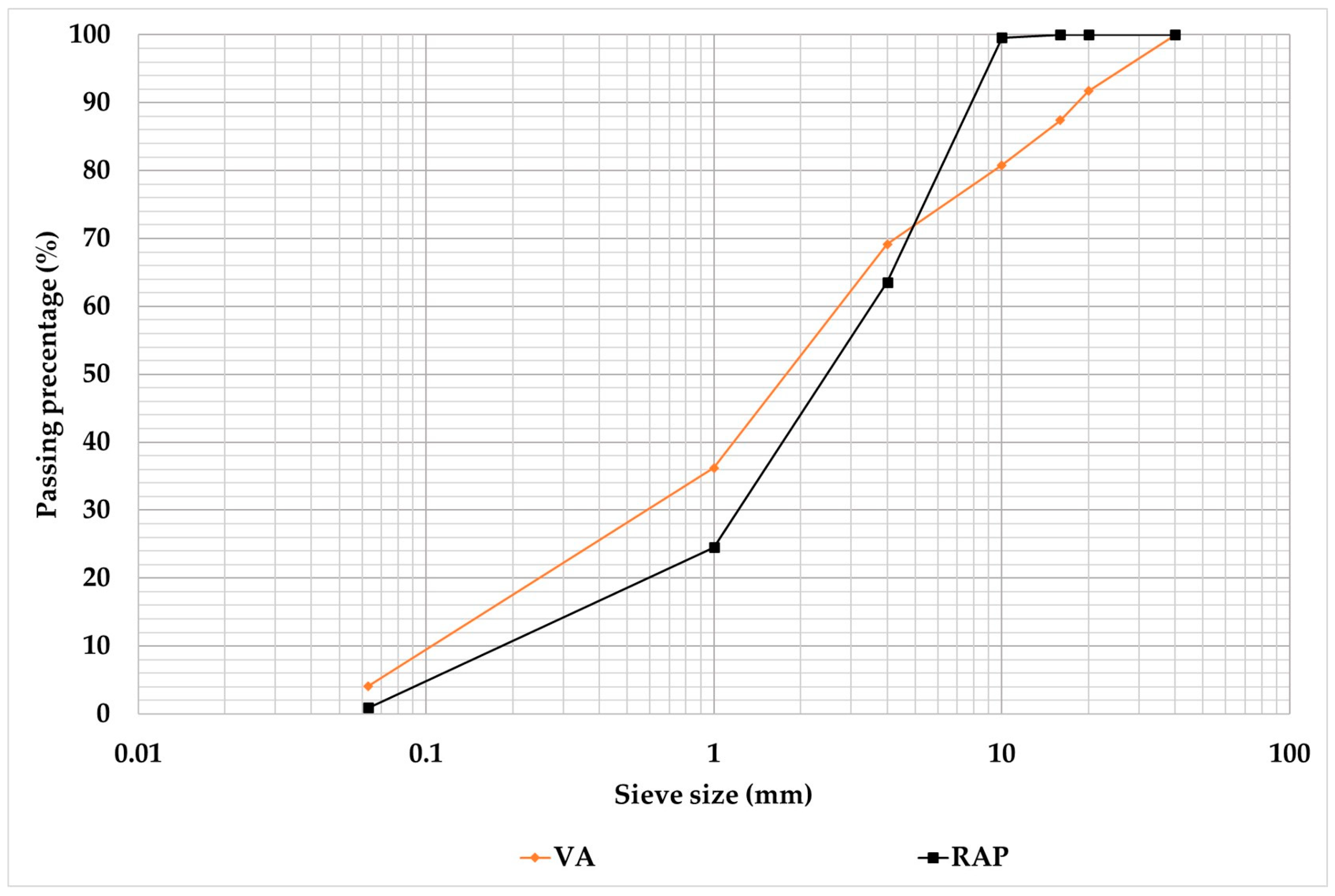
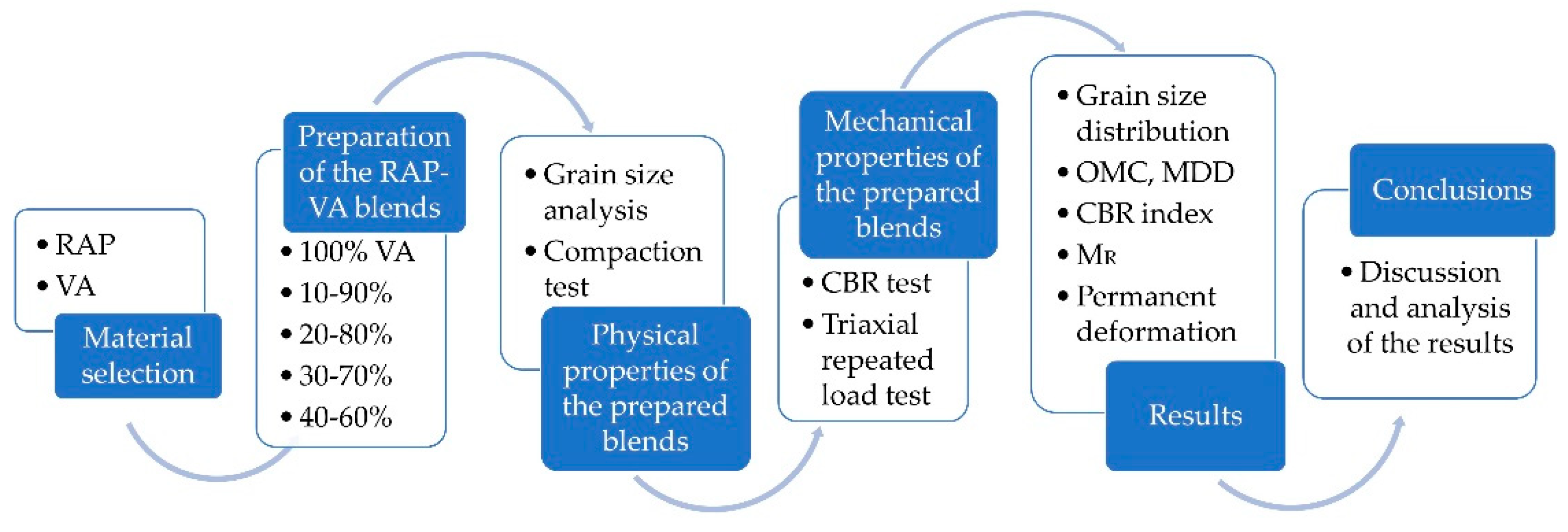
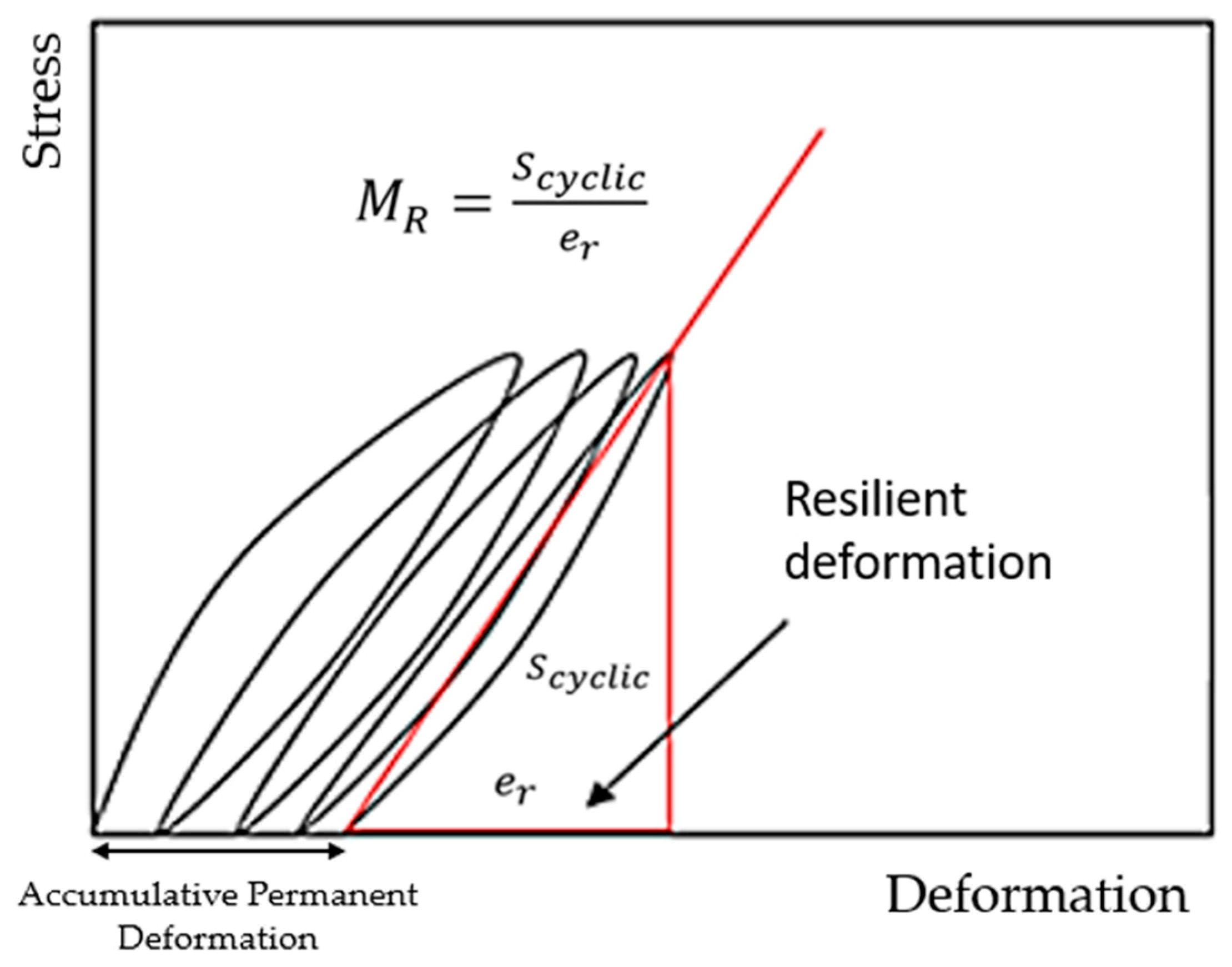
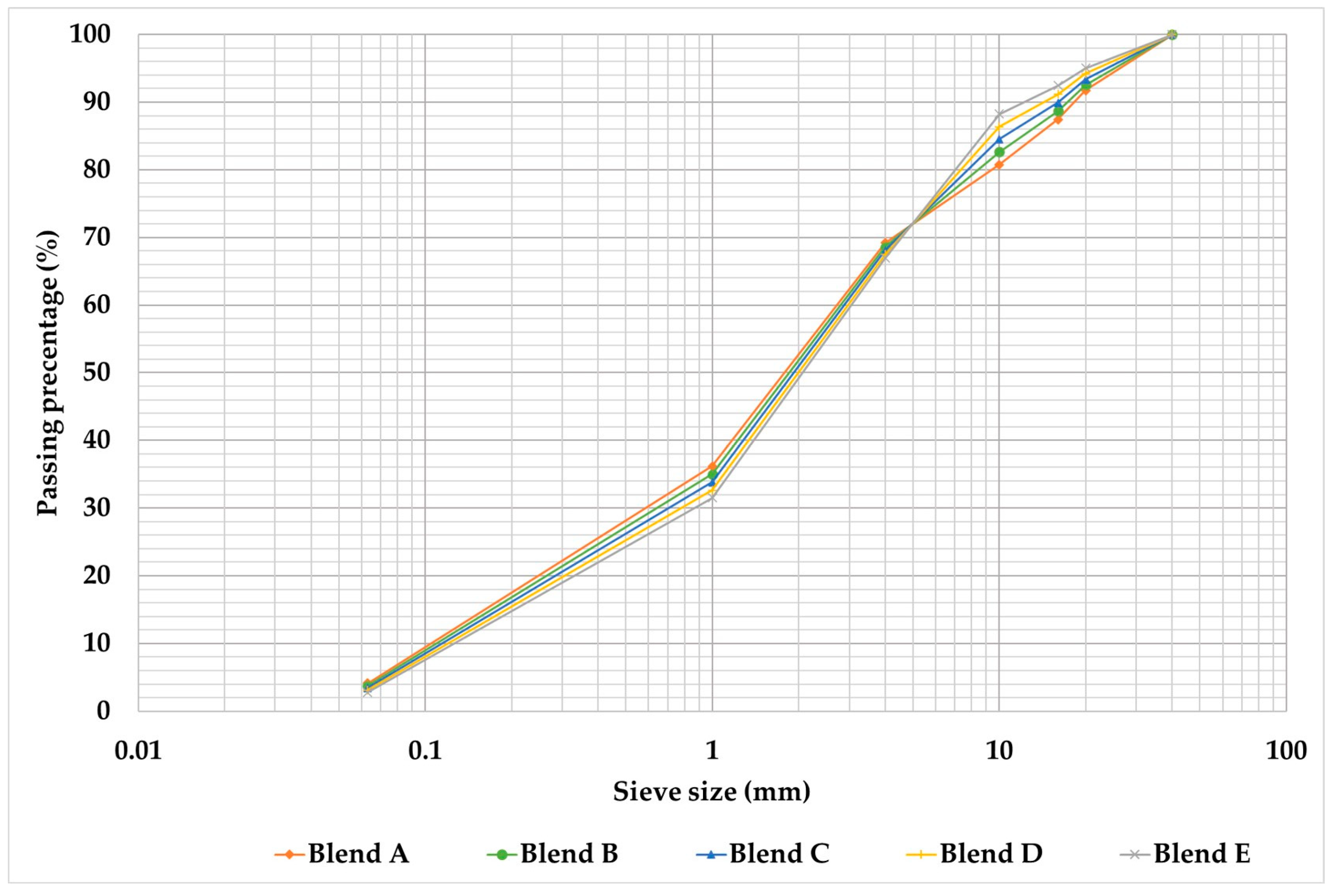
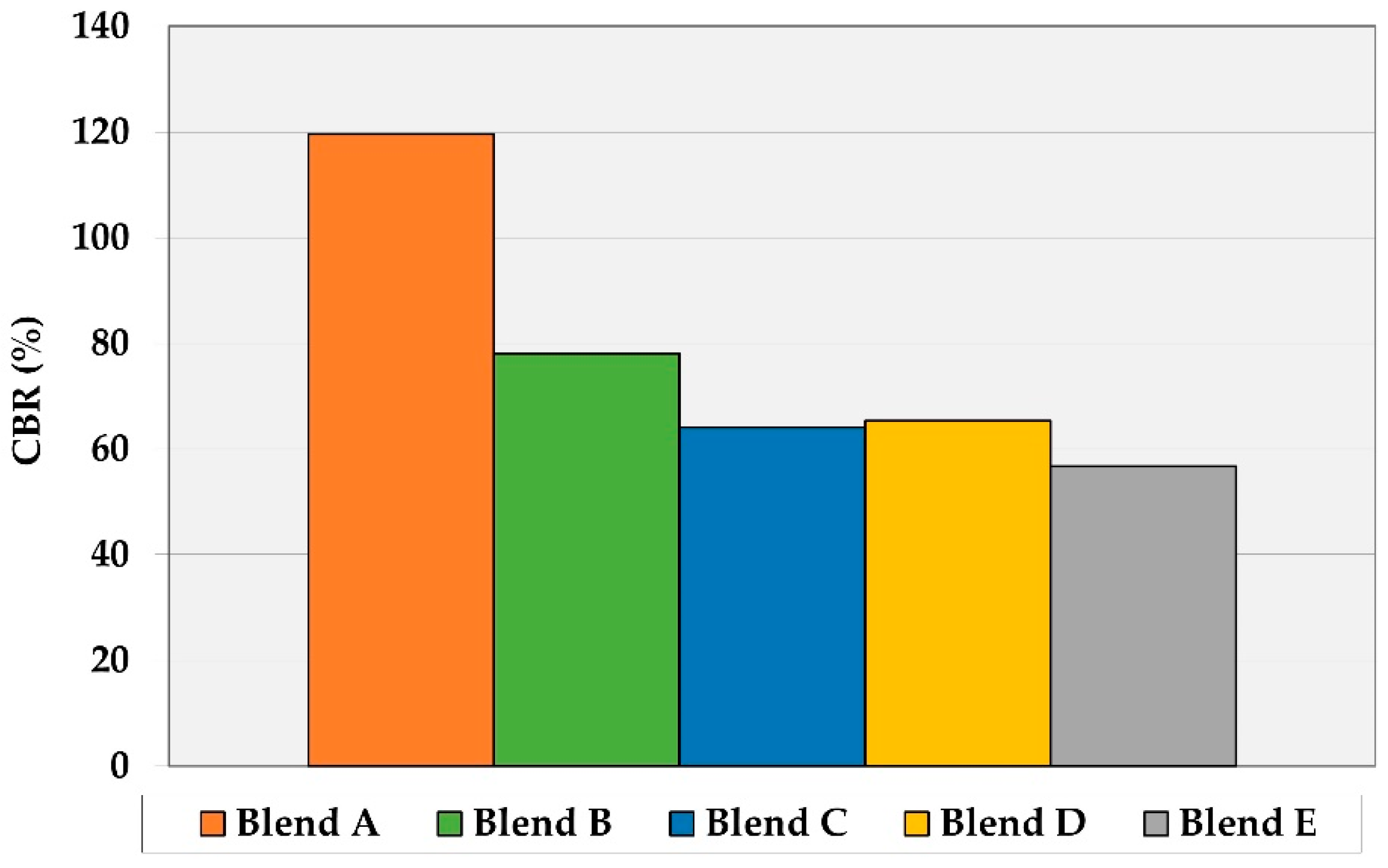
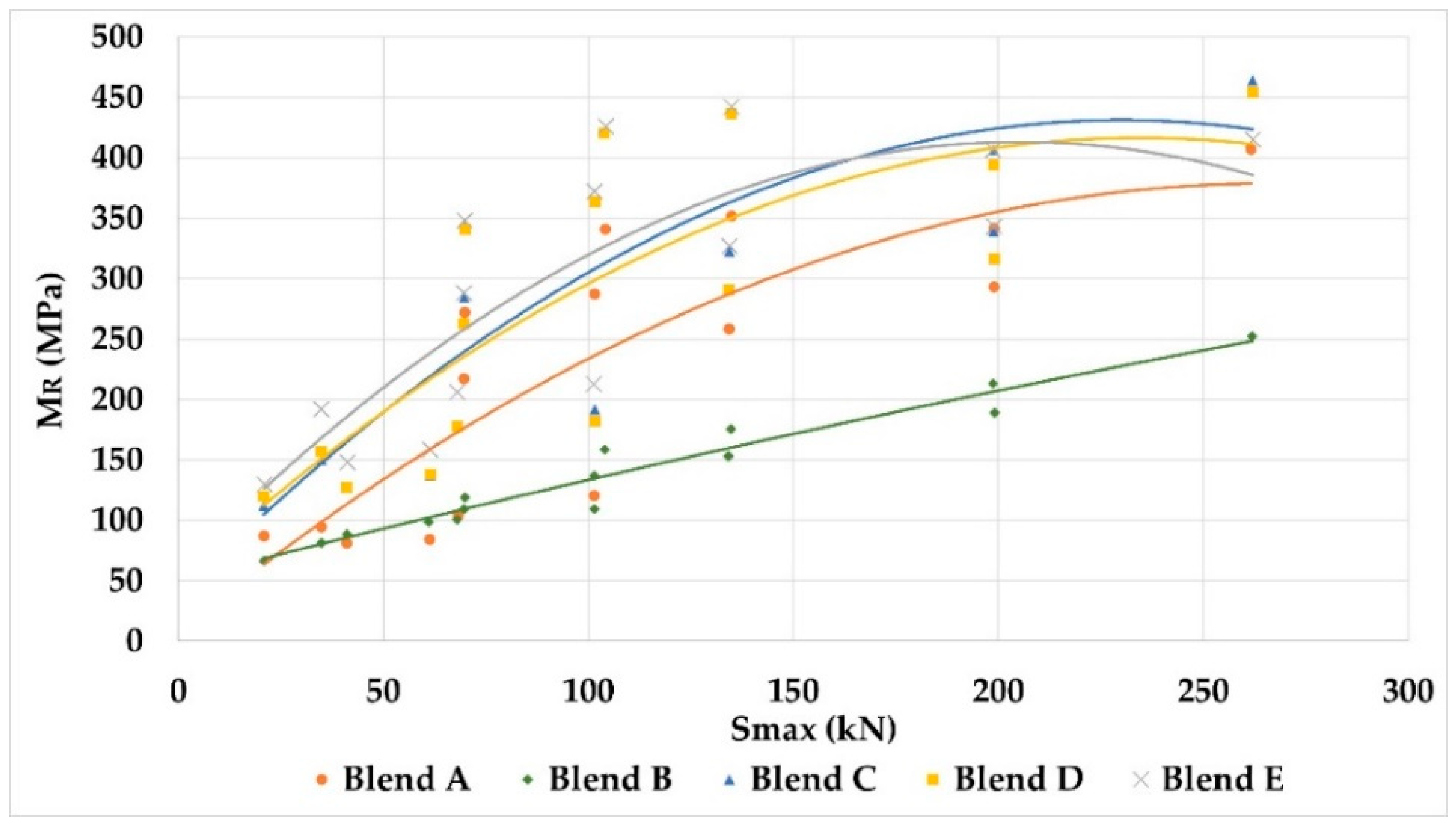
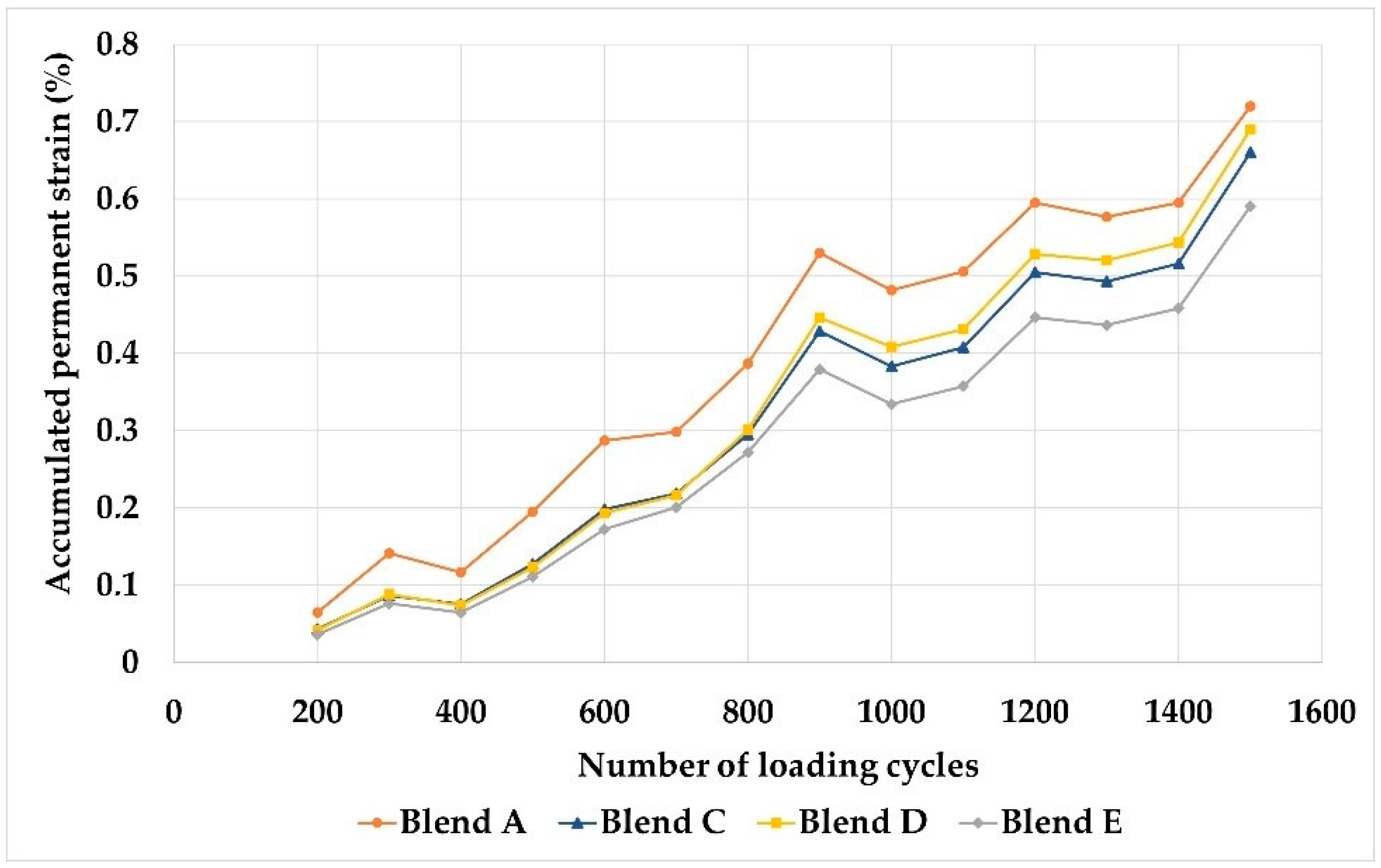
| Blend | RAP (%) | VA (%) |
|---|---|---|
| A | 0 | 100 |
| B | 10 | 90 |
| C | 20 | 80 |
| D | 30 | 70 |
| E | 40 | 60 |
| Coefficients | Blend A | Blend B | Blend C | Blend D | Blend E |
|---|---|---|---|---|---|
| CU * | 29 | 40 | 30 | 23 | 23 |
| CC ** | 1.24 | 1.225 | 1.87 | 1.64 | 2.07 |
| Blend A | Blend B | Blend C | Blend D | Blend E | |
|---|---|---|---|---|---|
| OMC * | 6.9% | 6.2% | 6.0% | 6.5% | 5.9% |
| MDD ** (kg/m3) | 2196 | 2130 | 2083 | 2065 | 2041 |
| Sequence No. | A | B | C | D | E | |||||
|---|---|---|---|---|---|---|---|---|---|---|
| MR (MPa) | Smax (kN) | MR (MPa) | Smax (kN) | MR (MPa) | Smax (kN) | MR (MPa) | Smax (kN) | MR (MPa) | Smax (kN) | |
| 1 | 86.88 | 20.91 | 66.46 | 20.93 | 111.65 | 20.82 | 119.85 | 20.82 | 129.78 | 20.96 |
| 2 | 80.85 | 41.14 | 88.36 | 41.14 | 127.60 | 41.14 | 127.17 | 41.15 | 148.19 | 41.26 |
| 3 | 84.00 | 61.41 | 98.47 | 61.05 | 137.55 | 61.52 | 137.76 | 61.58 | 158.46 | 61.47 |
| 4 | 94.52 | 34.86 | 81.13 | 34.93 | 150.09 | 34.89 | 157.07 | 34.90 | 192.03 | 34.89 |
| 5 | 103.83 | 68.29 | 100.50 | 68.03 | 178.17 | 68.12 | 177.42 | 68.11 | 206.17 | 68.01 |
| 6 | 120.39 | 101.53 | 109.25 | 101.47 | 191.95 | 101.65 | 182.20 | 101.67 | 212.84 | 101.37 |
| 7 | 217.20 | 69.70 | 109.26 | 69.73 | 284.59 | 69.71 | 262.52 | 69.66 | 287.88 | 69.71 |
| 8 | 258.12 | 134.41 | 153.08 | 134.21 | 322.68 | 134.40 | 290.74 | 134.33 | 327.16 | 134.42 |
| 9 | 293.16 | 199.00 | 189.08 | 199.12 | 339.26 | 198.84 | 316.06 | 199.15 | 342.86 | 199.03 |
| 10 | 271.82 | 69.91 | 118.77 | 69.89 | 343.25 | 69.92 | 340.80 | 70.06 | 348.23 | 69.85 |
| 11 | 287.07 | 101.56 | 136.83 | 101.51 | 364.08 | 101.76 | 363.45 | 101.75 | 372.16 | 101.57 |
| 12 | 341.26 | 199.02 | 213.13 | 198.73 | 406.55 | 198.82 | 393.75 | 198.92 | 406.59 | 198.74 |
| 13 | 340.84 | 104.22 | 158.68 | 104.07 | 420.92 | 103.94 | 420.30 | 103.97 | 425.91 | 104.26 |
| 14 | 351.91 | 135.01 | 175.66 | 134.84 | 436.23 | 134.92 | 436.50 | 134.94 | 442.02 | 134.92 |
| 15 | 406.99 | 261.75 | 252.26 | 262.02 | 464.49 | 262.10 | 454.35 | 262.17 | 415.29 | 262.15 |
Disclaimer/Publisher’s Note: The statements, opinions and data contained in all publications are solely those of the individual author(s) and contributor(s) and not of MDPI and/or the editor(s). MDPI and/or the editor(s) disclaim responsibility for any injury to people or property resulting from any ideas, methods, instructions or products referred to in the content. |
© 2022 by the authors. Licensee MDPI, Basel, Switzerland. This article is an open access article distributed under the terms and conditions of the Creative Commons Attribution (CC BY) license (https://creativecommons.org/licenses/by/4.0/).
Share and Cite
Plati, C.; Tsakoumaki, M.; Gkyrtis, K. Physical and Mechanical Properties of Reclaimed Asphalt Pavement (RAP) Incorporated into Unbound Pavement Layers. Appl. Sci. 2023, 13, 362. https://doi.org/10.3390/app13010362
Plati C, Tsakoumaki M, Gkyrtis K. Physical and Mechanical Properties of Reclaimed Asphalt Pavement (RAP) Incorporated into Unbound Pavement Layers. Applied Sciences. 2023; 13(1):362. https://doi.org/10.3390/app13010362
Chicago/Turabian StylePlati, Christina, Maria Tsakoumaki, and Konstantinos Gkyrtis. 2023. "Physical and Mechanical Properties of Reclaimed Asphalt Pavement (RAP) Incorporated into Unbound Pavement Layers" Applied Sciences 13, no. 1: 362. https://doi.org/10.3390/app13010362
APA StylePlati, C., Tsakoumaki, M., & Gkyrtis, K. (2023). Physical and Mechanical Properties of Reclaimed Asphalt Pavement (RAP) Incorporated into Unbound Pavement Layers. Applied Sciences, 13(1), 362. https://doi.org/10.3390/app13010362










